Between 1912 and 1922, Irish female unionists, nationalists, home rulers, republicans, socialists, Protestants, Roman Catholics, Quakers and those without religion actively contributed to the revolutionary events in Dublin, the capital city of Ireland. Whether living in the tenements or the suburbs, most Dublin women coped with everyday life. Yet, the issues of home rule, the Dublin lock-out, the outbreak of world war one, the Easter rising in 1916 and the war of independence affected their lives in a variety of ways. Points of interest in this section of the website were chosen to illustrate the complexity of women’s role in key events in Dublin’s history.
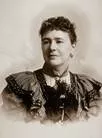
Áras an Uachtaráin, Phoenix Park, was the residence of the Lord Lieutenant of Ireland.
Lord Aberdeen was Lord Lieutenant of Ireland in 1886 and from 1905 to 1915. His wife Lady Ishbel Maria Gordon, Lady Aberdeen (1857-1939), played a major role in philanthropy during her time in Ireland.
Lady Aberdeen, suffragist, Home Ruler and campaigner for social reform established the Irish Home Industries Association which attempted to unify all the cottage industries operating throughout the country at the time.
In 1907, during her second sojourn in Ireland, she founded the Women’s National Health Association (WNHA). It was a voluntary organisation that aimed to improve mother and child welfare and to help in the fight against tuberculosis, which was rife in Ireland during this period. There were 155 branches of the association throughout the country by 1910.
Lady Aberdeen and the WHNA founded the Peamount Sanitorium to treat tuberculosis. It opened in 1912.
While she achieved a great deal during her time in Ireland, she was disliked by nationalists who saw her brand of philanthropy as patronising and interfering with Irish affairs.
- Lady Aberdeen died at her home, Gordon House, Aberdeen, Scotland on 18 April, 1939.
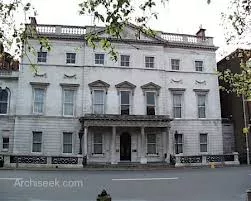
Iveagh House, St Stephen’s Green
On the steps of Iveagh House, St Stephen’s Green, Margaret ‘Meg’ Connery of the Irish Women's Franchise League protested during the visit of Edward Carson, MP for Trinity and Ulster Unionist Party leader, as she campaigned for votes for women.
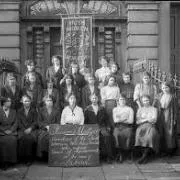
Irish women workers outside Liberty Hall (Keogh Collection, National Library of Ireland)
Liberty Hall
Liberty Hall was the headquarters of the Irish Transport and General Workers’ Union and the Irish Citizen Army. Its basement was also used as a munitions factory in the months before the rising staged by republicans during Easter, 1916.
The Irish Citizen Army (ICA) was formed in November 1913 to protect workers during the 1913 Lockout from police brutality. Women were an integral part of the army and were treated equally to the men.
Members of the Irish Women Workers Union, The Irish Citizen Army, The Irish Women’s Franchise League (link) and Inghinidhe na hÉireann (link) prepared food for the families of the union members affected by the Lockout, serving approximately 3,000 people every day in the basement of Liberty Hall.
In 1916, women and girls were active in Liberty Hall preparing munitions and first aid equipment for the Easter Rising. The female members of the Irish Citizen Army were stationed throughout the city during the rebellion, transporting civilians, arms and ammunition. One prominent member of the ICA, Countess Markievicz, was second in command at the garrison at St. Stephen’s Green.
Liberty Hall was destroyed during the Rising. The current building was opened on 1 May 1965.
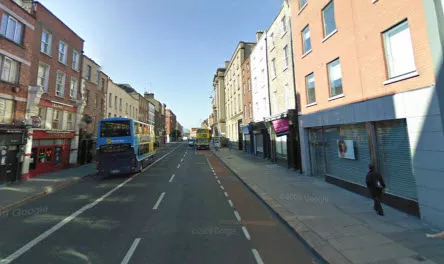
The outbreak of world war one in 1914 brought challenges for Irishwomen. Women engaged in various forms of war work. Women who were dependants of soldiers received a ‘separation’ allowance, which could be obtained, for example, at the Post Office in 68 Aungier Street. As Caitriona Clear indicated, these women were ‘viewed with disdain for their personal lack of morals (allegedly spending their allowance on alcohol) and after the 1916 Rising their lack of patriotism.’ (Clear, p. 174)
Caitriona Clear, ‘Fewer ladies, more women’ in John Horne (ed.), Our War: Ireland and the Great War, (Dublin, 2008), pp. 157-81.

General Post Office
The General Post Office (GPO) on Sackville Street (now O’Connell Street) Dublin, was the republican headquarters during the Easter Rising 1916.
Initially, Winifred Carney was the first and only woman to be stationed at the GPO. However, over the next two days more women arrived and it is estimated that there were 40 women in the building by the end of the week.
The women, members of Cumann na mBan and the Irish Citizen Army, staffed the hospital which had been established at the back of the building, washed clothes and cooked food. They also played an important role as couriers, transporting ammunition and dispatches to the various garrisons around the city, risking sniper fire in the process.
When the leaders of the Rising decided to concede defeat, they chose Cumann na mBan member, Elizabeth O‘Farrell to deliver the message of surrender to the British army stationed on Moore Street.
The GPO was destroyed by fire during the Rising and remained derelict until 1925 when the Irish Free State government began renovations. It was reopened on 11 July 1929. The only part of the original building that still exists is the facade.

Many of the approximately 150 women who took part in the 1916 rising were subsequently imprisoned in Kilmainham Gaol and later transferred to Mountjoy jail. More than 300 were imprisoned in Kilmainham Gaol during the Irish Civil War
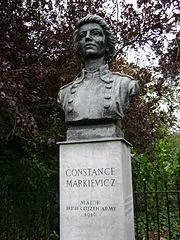
Constance Markievicz (1868-1927) was a member of Inghinidhe na hEireann, founder of the Fianna, member of the Irish Citizen Army and second-in-command at St Stephen’s Green in 1916. She was sentenced to death but commuted to life imprisonment. She was the first woman elected to the British House of Commons in the 1918 general election and made Minister for Justice in the First Dail. She opposed the 1921 treaty.
There are a number of seats in St Stephen's Green dedicated to women such as Louie Bennett (1870-1956) and Helen Chevenix (1890-1963), both of whom were active on behalf of women workers, female suffrage and pacificism. Bennett was general secretary and executive committee member and the first woman president of the ITUC in 1932 and again in 1948. Chenevix was general secretary of the Irish Women Workers’ Union, a member of the ITUC executive and president in 1951.
There is also a seat in honour of Anna and Thomas , social reformers and suffragists.
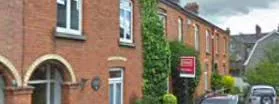
Home of Hanna and Francis Sheehy Skeffington. Hanna Sheehy was born in 1877 in Kanturk, county Cork. She gained a B.A. in French and German in 1899 and was awarded an M.A. in 1902. She married Francis Skeffington who took her name. Both were suffragists. In 1916 Hanna supported the Volunteers because they had enshrined votes for women in the 1916 proclamation. Frank opposed it due to his pacifist beliefs. His murder on 26 April 1916 led her to campaign for a full inquiry into the circumstances and ultimately established Francis' innocence. Afterwards she campaigned in Ireland and the US against British rule in Ireland. She opposed the 1922 treaty as did many in Cumann na mBan. She campaigned extensively on women's issues until her death in 1946.
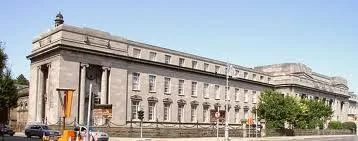
Earlsfort Terrace, Concert Hall (formerly University College Dublin)
Mary Hayden was profesor of Modern History from 1911 to 1938. Campaigner for women's rights in education, she established the Women's Graduation Association. She was a friend of Padraig Pearse, but as he pursued the militarist path, their relationship diminished for she was a pacifist.